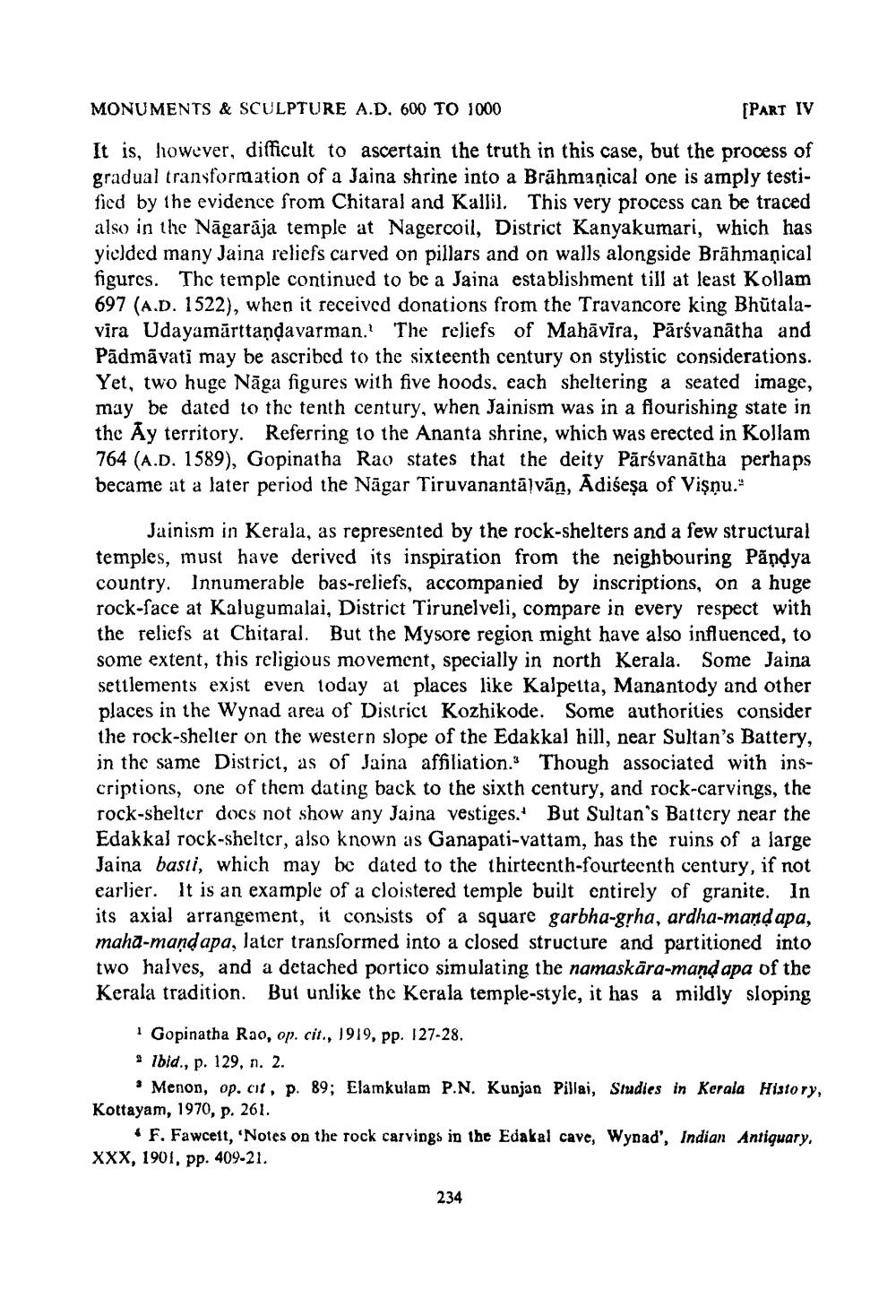________________
MONUMENTS & SCULPTURE A.D. 600 TO 1000
[PART IV
It is, however, difficult to ascertain the truth in this case, but the process of gradual transformation of a Jaina shrine into a Brāhmaṇical one is amply testified by the evidence from Chitaral and Kallil. This very process can be traced also in the Nāgarāja temple at Nagercoil, District Kanyakumari, which has yiclded many Jaina reliefs carved on pillars and on walls alongside Brāhmanical figures. The temple continued to be a Jaina establishment till at least Kollam 697 (A.D. 1522), when it received donations from the Travancore king Bhūtalavira Udayamărttandavarman. The reliefs of Mahāvira, Pārsvanātha and Pādmavati may be ascribed to the sixteenth century on stylistic considerations. Yet, two huge Nāga figures with five hoods, cach sheltering a seated image, may be dated to the tenth century, when Jainism was in a flourishing state in the Āy territory. Referring to the Ananta shrine, which was erected in Kollam 764 (A.D. 1589), Gopinatha Rao states that the deity Pārsvanātha perhaps became at a later period the Nāgar Tiruvanantāvān, Adiśeşa of Vişnu."
Jainism in Kerala, as represented by the rock-shelters and a few structural temples, must have derived its inspiration from the neighbouring Pandya country. Innumerable bas-reliefs, accompanied by inscriptions, on a huge rock-face at Kalugumalai, District Tirunelveli, compare in every respect with the reliefs at Chitaral. But the Mysore region might have also influenced, to some extent, this religious movement, specially in north Kerala. Some Jaina settlements exist even today at places like Kalpetta, Manantody and other places in the Wynad area of District Kozhikode. Some authorities consider the rock-shelter on the western slope of the Edakkal hill, near Sultan's Battery, in the same District, as of Jaina affiliation. Though associated with inscriptions, one of them dating back to the sixth century, and rock-carvings, the rock-shelter docs not show any Jaina vestiges. But Sultan's Battery near the Edakkal rock-shelter, also known as Ganapati-vattam, has the ruins of a large Jaina basti, which may be dated to the thirteenth-fourteenth century, if not earlier. It is an example of a cloistered temple built entirely of granite. In its axial arrangement, it consists of a square garbha-gyha, ardha-mandapa, maha-mandapa, later transformed into a closed structure and partitioned into two halves, and a detached portico simulating the namaskāra-mand apa of the Kerala tradition. But unlike the Kerala temple-style, it has a mildly sloping
Gopinatha Rao, op. cit., 1919, pp. 127-28. * Ibid., p. 129, n. 2.
* Menon, op. cit, p. 89; Elamkulam P.N. Kunjan Pillai, Studies in Kerala History, Kottayam, 1970, p. 261.
* F. Fawcett, 'Notes on the rock carvings in the Edakal cave, Wynad', Indian Antiquary, XXX, 1901, pp. 409-21.
234




